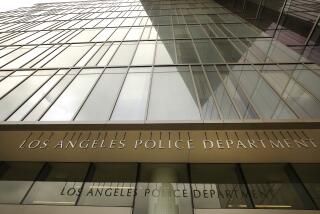Dentist Calls Bites on Hubbard ‘Consistent’ With Victim’s Teeth : Crime: Defense says indentations on policeman’s shoulder blades are pressure points, not bite marks.
Bite marks on the back of San Diego Police Officer Henry Hubbard Jr., accused of attempted murder and attempted robbery in an attack on two men last month, are “consistent” with the teeth of one of his victims, according to a forensic dentist hired as an expert witness in the case.
The markings “illustrate a certain connection between a victim and a suspect,” said Dr. Norman Sperber, who has testified as an expert in more than 100 criminal cases since 1978. “It means that, from one person’s teeth, consistent marks were left on another person.”
Sperber’s report documents yet another piece of evidence against Hubbard, 29, a police officer charged with shooting two young men on Torrey Pines State Beach. Police say a gunman wearing a stocking over his head attempted to rob two men and shot them during a struggle early on the morning of Aug. 15.
Hubbard checked into a hospital an hour after the incident with a gunshot wound in his hand and told police he had been attacked by three men on the freeway shortly after leaving work.
Kerry Steigerwalt, an attorney for Hubbard, said Monday that he was generally familiar with the contents of Sperber’s report and did not accept its findings.
There are two “symmetrical indentations” on each of Hubbard’s shoulder blades that were not caused by biting, he said.
“I have a doctor who says these are not bite marks at all but pressure points on the back of my client,” Steigerwalt said. “The victims are not testifying to biting. Nobody has said anything at all about biting. I don’t think (Sperber) is correct.”
In an interview Monday, Sperber said the markings he has studied in the Hubbard case do not rate a “reasonable” or “highly probable” level of dental certainty that the markings match, higher rankings that he has assigned in other cases.
“If I had more teeth touching, it would have made a better identification,” he said. “What we have here is like a partial fingerprint. But you take that bite mark into court with other forensic evidence and let the jury weigh the entire matter.”
Sperber, who once linked nine of Ted Bundy’s teeth to one of his sorority victims, said the more teeth that are imprinted, the stronger the chances of identification. The forensic dentist said he usually relies on photographs of the bite mark or can take an impression of the bite if necessary.
“The more teeth the merrier,” he said. “So if you have 12 teeth, and they are all marking in the bite area, they provide a higher degree of certainty. If you have one or two teeth that are unusual or broken, that helps.”
Although he could not remember specifically how many teeth had been imprinted in the Hubbard case, he said it was fewer than the nine markings he had in the Bundy case.
So far, evidence outlined in court against Hubbard include statements that his flashlight, engraved with his name and police ID number, was found at the scene, that sand was discovered in his clothing and that a bullet from a victim’s body and shell casings at the scene match the caliber of a handgun registered to Hubbard.
In addition, tests show that enzymes in Hubbard’s blood match blood samples found at the scene, and blood samples taken from Hubbard match those of one of the victims.
Hubbard’s attorneys have discounted all of the evidence, suggesting instead that Hubbard was beaten by three men after his car broke down on the freeway. The attackers struggled with him, during which time his gun discharged and his weapon and flashlight were stolen, his attorneys said.
Held on $2-million bail at the Central Jail downtown, Hubbard is scheduled for a preliminary hearing Oct. 23.
He is charged with two counts of attempted murder and two counts of attempted burglary, and is the prime suspect in a series of six other attacks including rape and robbery at San Diego-area beaches.
More to Read
Sign up for Essential California
The most important California stories and recommendations in your inbox every morning.
You may occasionally receive promotional content from the Los Angeles Times.










